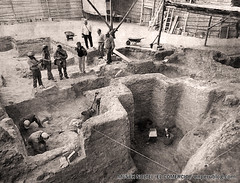The benefits of Maca – specifically osteoporosis
The human body is an imperfect machine. We can walk and we can run, but the moment arrives when we sprain our knees and our legs are too tired to go on. We are able to see objects clearly whether they are far or near, but almost all of us encounter problems with our vision at some point in our lives. The same happens with the bones.
From birth, the cells that naturally destroy the damaged bone live in harmony with those that form new bone. However, once we pass our 30s a disbalance occurs and new bone is created slower that old bone is destroyed.
In women this process is sped up by the menopause. The bones loose density and become weak and porous, a process called osteoporosis. Usually doctors prescribe hormone replacement therapy, increasing the oestrogen in the body to slow down the process. However, in some cases, although it is effective and reduces the possibility of bone fractures, it can also affect other organs and increases the risk of breast and uterus cancer.
Introduction to Maca
A year ago a group of medical researchers from Peru’s Universidad Peruana Cayetano Heredia, headed by Carla Gonzales, decided to study an ancient plant that they suspected could have positive affects on human bones.
Domesticated in Peru millennia ago, Maca was an essential crop for use in the alimentation of ancient Peruvians. Its affects on the body were numerous. It raised energy levels – Inca warriors would consume it before battles and messengers would consume it to be able to run up and down mountains day after day, old people who consumed it would work in the fields as if they were young. It would ward-off disease, increase fertility and could even be used to treat depression.
With the Spanish conquest and the passing of time, its benefits and uses would be almost forgotten and it was planted less and less. In 1961 the Maca plant was on the edge of extinction, only saved when Peruvian biologist Gloria Chacón began to study its amazing properties. Thanks to her, we have added to the list Maca’s ability to;
- Increase sperm production
- Enhance memory
- Reduce the size of the prostate in older men
- Protect against the damaging effects of ultraviolet light from the sun
But not all Maca is equal. Just like there are countless variations of that other Andean crop, the potato, Maca has eleven varieties, distinguishable by the colour of its root. The most studied for its effects are the Red and the Black. “The black maca is a more of a sperm producer while the red acts more on the prostate for example. We decided to study the red maca because it has an affect on oestrogen regulation, the hormone vital for the health of the bones”, Gonzales explained.
Specifically Osteoporosis
The first scientific discovery regarding maca and osteoporosis was in 2006 when Chinese scientist Yong-zhong Zhang studied the affects of maca on rats that had been induced with osteoporosis. It was this that inspired the Peruvian investigators to delve deeper. They wanted to compare the effects of red maca against the traditional treatment of hormone replacement with the synthetic estradiol. They induced osteoporosis in 30 lab rats and treat half of them with red maca and the other half with hormone replacement.
The rats on maca developed an incredible capacity for bone regeneration, far greater than those rats on traditional treatment.

“With estadiol the pores in the bone shrunk and the affects of the osteoporosis diminished. With the maca the same happened, but on a far greater scale. But the biggest benefit is that the weaving of the bone is not damaged like it is with hormone replacement. Whatsmore, maca is far less expensive”.
Gonzales predicts that within years, red maca will replace traditional treatment for osteoporosis around the world. The team, having successfully found a way to revert bones damaged by osteoporosis to healthy status, are now looking into the affects of maca on other oestrogen-related organs such as the breast and uterus.
Exports of Maca are on the increase as treatments and medicines are developed that make use of the plant. The team of researchers have developed an extract that can be taken as a food supplement. These sachets developed by the team contain the equivalent of ten whole maca roots, reduced to 30 grams.
“It is recommended that one sachet is consumed daily for sufficient effect (no less if you are replacing traditional therapy), mix it with fruit juice as red maca has a very strong taste”, Gozales indicates. “Many doctors are now prescribing it. We are exporting to the United States and Asia. There’s a lot of interest in natural medicine and in reducing the use of chemical composites in drugs. It is also of huge benefit to the thousands of rural workers that grow maca in the Andes above 4,000m of altitude. It is a blessing”.
Tags: health, maca, medical, medicine, traditions









